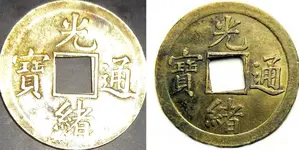What caught my eye about the coins in this post are the "rust" spots in the image (if those are rust spots on the coins). I remember reading in a Chinese language coin forum last year about rust on coins. Basically, from that forum, rust is an indication the coins are fabrications and not original mints.
Is there a technique to determine if they are reproductions?
It’s tricky! Cash coins of this type were produced at a time when China was attempting to modernise and standardise its coinage, moving away from the old system where coins were tied to a volatile fluctuating silver standard and a unit of weight called the “tael”. Many of the older cast copper/bronze cash were sufficiently heavy that the melt value of the copper exceeded the equivalent ‘face’ value of the coin against the silver standard. This was exacerbated by a decline in the global value of silver from about 1871 onwards. The cost of producing copper/bronze cash coins by casting had become higher than their face value by about a third.
So, these coins were more efficiently machine-produced rather than cast, thinner and lighter than the cast coins they were intended to replace, and struck in cheaper brass alloy with a rather garish yellow colour.
They can usually be grouped into “large” (with a diameter of approximately 24mm) or small (with a diameter of approximately 20mm) with weights ranging from about 2.8g to about 3.1g and occasionally up to about 3.4g. All of them with a one cash denomination. They’re thin (below 1mm and usually about 0.9mm or below). The width of the flat rim around the edge also varies.
‘Modern’ (ie non-contemporary imitations produced as charms and good-luck pieces) can often be identified by having non-standard characters which may include characters expressing wishes for wealth, long life or good luck, but that isn’t always the case. There are also contemporary copies produced unofficially by merchants to meet the demand for trade coinage due to the limited output from the official mints.
I don’t know about the “rust spots” Yang hao referred to, but genuine coins would have no iron content and not be attracted to a magnet.
All I could say is that yours look to have faithful characters for genuine coinage, a typical colouration for the brass alloy used, and your description of them being “very light cheap like coins not heavy or thick” is consistent with genuine coins (if they fall within the dimensions I gave above).
The remarkable condition and the fact you have 30 of them is not an indicator that they are modern since, as I said, these coins seem to have been unpopular in use, were often hoarded, and didn’t see much circulation. Is there a back-story? How did you come to have these coins? If they were part of an accumulation of Chinese junk that included charms and such, or modern items, I would be suspicious of their authenticity on a “guilt by association” basis.




